The information in this article applies to:

QUESTION
How can I create exposed roof trusses in a room with a cathedral ceiling?

ANSWER
When a roof truss is drawn in Chief Architect, the program locates a roof plane to define the top chords of the truss, and a ceiling plane to define the location of the bottom chord. You can create exposed trusses by creating a ceiling to define where you want the trusses' bottom chords, drawing the trusses, and then removing the ceiling.
To set up the structure
-
Open
 the plan file in which you would like to create exposed roof trusses.
the plan file in which you would like to create exposed roof trusses.
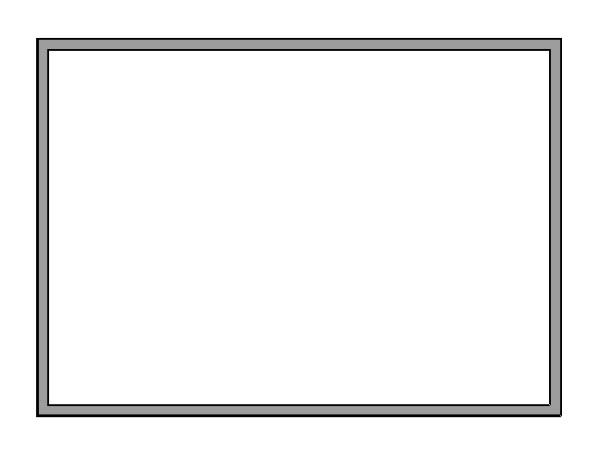
- In this example, a simple rectangular structure with a gable roof is used.
- If your plan has multiple floors, go to the floor where you want to create exposed trusses.
- Using the Select Objects
 tool, click in the center of the room to highlight it, then click the Open Object
tool, click in the center of the room to highlight it, then click the Open Object  edit button.
edit button.
- On the Structure panel of the Room Specification dialog that opens, set the Rough Ceiling height to the height for the wall top plates, then click OK.

If all rooms on this floor have the same plate height, it is best to set the Rough Ceiling value in the Floor Defaults.
- Next, select Edit> Default Settings
 , select the Framing category, then click Edit.
, select the Framing category, then click Edit.
- On the Trusses panel of the Framing Defaults dialog, specify the desired Member Depth and Maximum Horizontal Span properties, then click OK and Done to close the dialogs.
In this example, the Depth values are set at 8" and the Span values are unchanged.
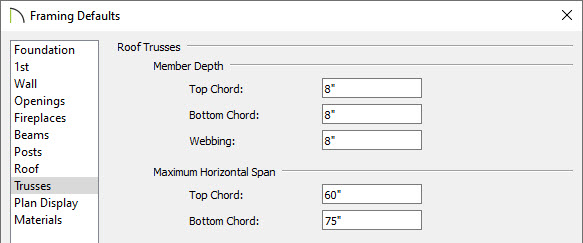
- Select Build> Roof> Build Roof
 and on the Roof panel of the Build Roof dialog that opens:
and on the Roof panel of the Build Roof dialog that opens:
- Check Build Roof Planes.
- Uncheck Auto Rebuild Roofs if it's checked.
- Select the Trusses Framing Method.
In X14 and prior versions, check the Trusses (no Birdsmouth) box instead.
- Specify the desired Pitch (in 12).
- Click OK to close the dialog and build the roof.
- Ceiling modifications may need to be made before generating your trusses. For example:
- Use the default flat ceiling to produce standard trusses.
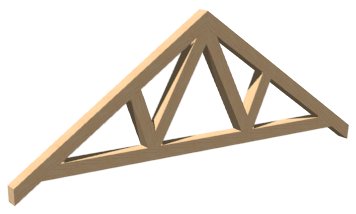
- Raise the ceiling height of a room if you'd like to create trusses with a raised bottom chord (make a note of the original value before doing so).
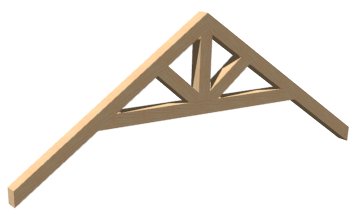
- Remove the default flat ceiling and draw sloped ceiling planes to produce scissor trusses. More on creating scissor trusses can be found in the Related Articles section below.
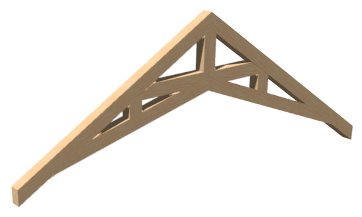
To draw and replicate the trusses
- Select Build> Framing> Roof Truss
 from the menu, then click and drag a line over the roof to create a single roof truss.
from the menu, then click and drag a line over the roof to create a single roof truss.
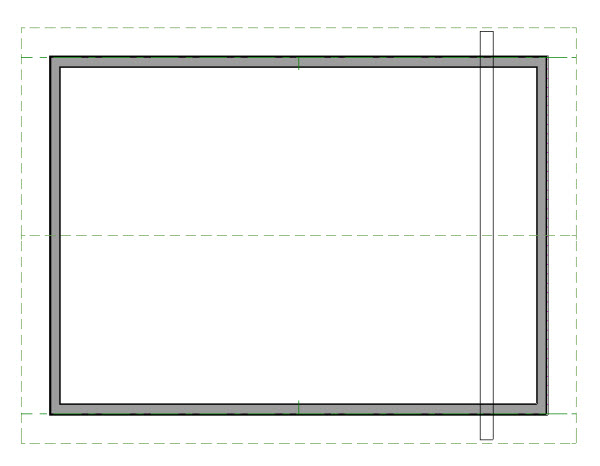
- Using the Select Objects
 tool, select the newly created truss and click the Open Object
tool, select the newly created truss and click the Open Object  edit button.
edit button.
- In the Roof Truss Specification dialog that opens:
- On the General panel, specify the Thickness.
In this example, an 8" thickness is specified to match the member properties set in the section above.
- On the Materials panel, specify your desired material for the truss.
- Click OK once all desired changes have been made.
- Next, move the truss into position over a non-bearing wall by either using its edit handles or by using a dimension line.
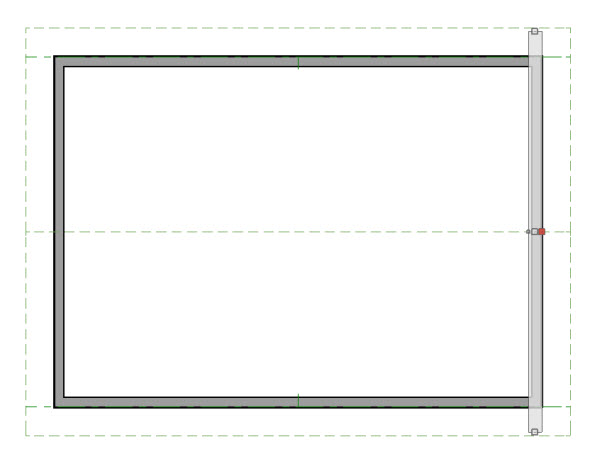
- With the first truss in place over an exterior wall, click on it to select it, then click the Multiple Copy
 edit button.
edit button.
- Next, click the Multiple Copy Interval
 edit button to open the Multiple Copy dialog:
edit button to open the Multiple Copy dialog:
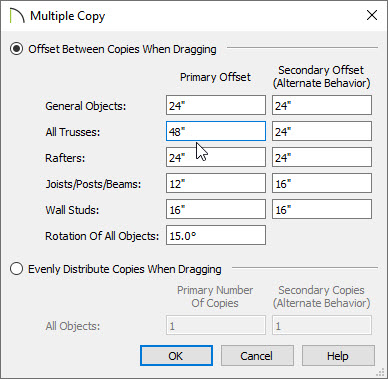
- Specify the desired Offset Between Copies When Dragging for All Trusses and click OK.
- When you click OK, the truss will still be selected and the Multiple Copy
 edit tool will still be active.
edit tool will still be active.
- Click and drag the truss perpendicular to itself using the Move
 edit handle to create copies of the truss at the specified intervals. As you drag, your cursor will display the Multiple Copy
edit handle to create copies of the truss at the specified intervals. As you drag, your cursor will display the Multiple Copy  icon.
icon.
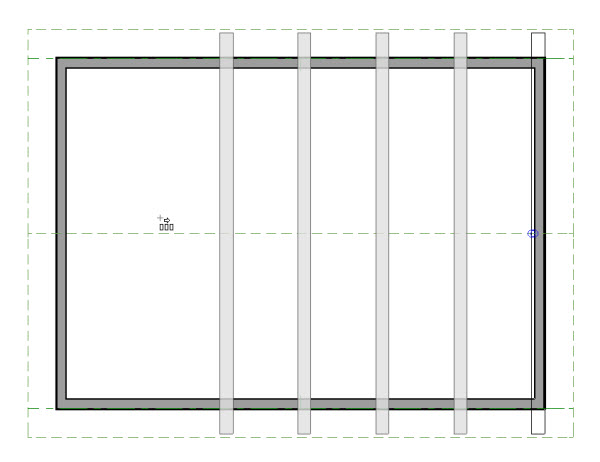
- When you have the desired number of trusses, release the mouse button.
To make the trusses exposed
- When your trusses are in place, use the Select Objects
 tool to select the room once again, then click the Open Object
tool to select the room once again, then click the Open Object  edit button.
edit button.
- In the Room Specification dialog that opens:
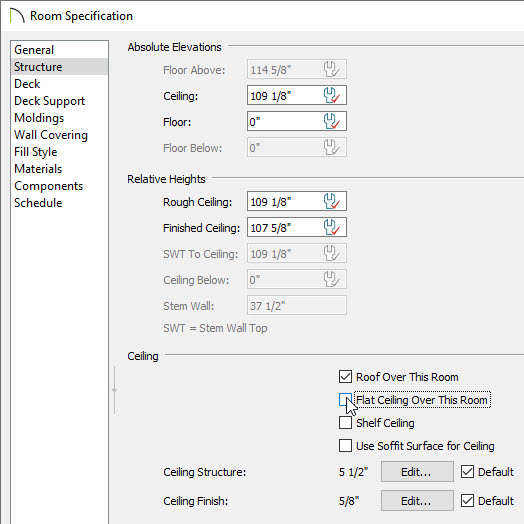
- On the Structure panel, uncheck the box beside Flat Ceiling Over This Room.
- If you changed the Ceiling height value to produce a modified truss (mentioned in Step 7 of the first section of this article), you may want to restore the previous value at this time.
- Click Edit next to Ceiling Finish if you'd like to change the thickness of the ceiling material.
- On the Materials panel, select the Ceiling Finish component, then click the Select Material button to choose your desired ceiling material.
- Under the Ceiling heading, remove the check beside Flat Ceiling Over This Room.
- Click OK once you have chosen a material, then click OK again to apply your changes.
- Select 3D> Create Perspective View> Full Camera
 from the menu, then click and drag a camera arrow inside the room where the trusses are.
from the menu, then click and drag a camera arrow inside the room where the trusses are.

- With the 3D view active, select Tools> Layer Settings> Display Options
 from the menu.
from the menu.
- In the Layer Display Options dialog, place a check in the Disp column next to the "Framing, Roof Trusses" layer, then click OK.
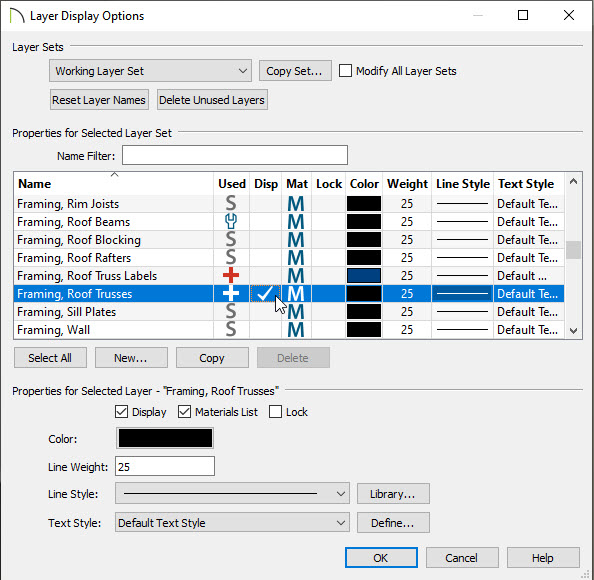
Your camera view may now look similar to the image below.
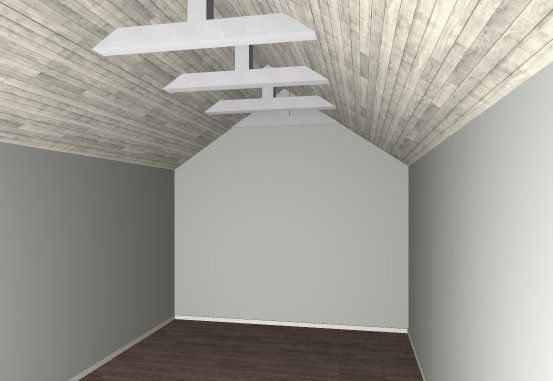
- If you would like the top chords of your trusses to be exposed, click on the roof planes above to select them, then click Open Object
 edit button.
edit button.
- In the Roof Plane Specification dialog that displays:
- On the General panel, lock the pitch by clicking the radio button to the right of the Pitch (in 12) text field, then increase the Baseline Height value.
In this example, the Baseline Height value was increased by 9 5/8". If your ceiling finish is a material other than drywall, such as tongue and groove for example, you may want to adjust this value accordingly.
- Click OK to close the dialog and apply the change.
Your exposed trusses are now in place. If you would like to make additional changes to the roof's structure, consider following the optional steps below.
- Navigate to Build> Framing> Build Framing
 , and on the Wall panel of the Build Framing dialog, uncheck Automatically Build Wall Framing, then click OK.
, and on the Wall panel of the Build Framing dialog, uncheck Automatically Build Wall Framing, then click OK.
-
Open
 the roof planes up to specification once more, and on the Structure panel, change the Rafter Depth, along with any other roof properties to your liking.
the roof planes up to specification once more, and on the Structure panel, change the Rafter Depth, along with any other roof properties to your liking.
If the rafter depth is changed prior to turning off automatic wall framing, your wall top plates may conflict with the exposed trusses. It's best to only perform this step after your walls are in place and the wall framing is complete.
Specifying a rafter depth value of 0" will allow the surface layers of the roof to sit directly on the trusses.








 from the menu, then click and drag a line over the roof to create a single roof truss.
from the menu, then click and drag a line over the roof to create a single roof truss. 

 edit button.
edit button. 
 edit tool will still be active.
edit tool will still be active.
 edit button.
edit button. 
 from the menu, then click and drag a camera arrow inside the room where the trusses are.
from the menu, then click and drag a camera arrow inside the room where the trusses are.
 from the menu.
from the menu. 

 edit button.
edit button.